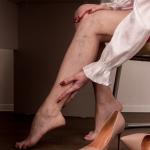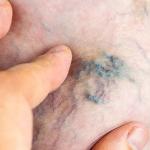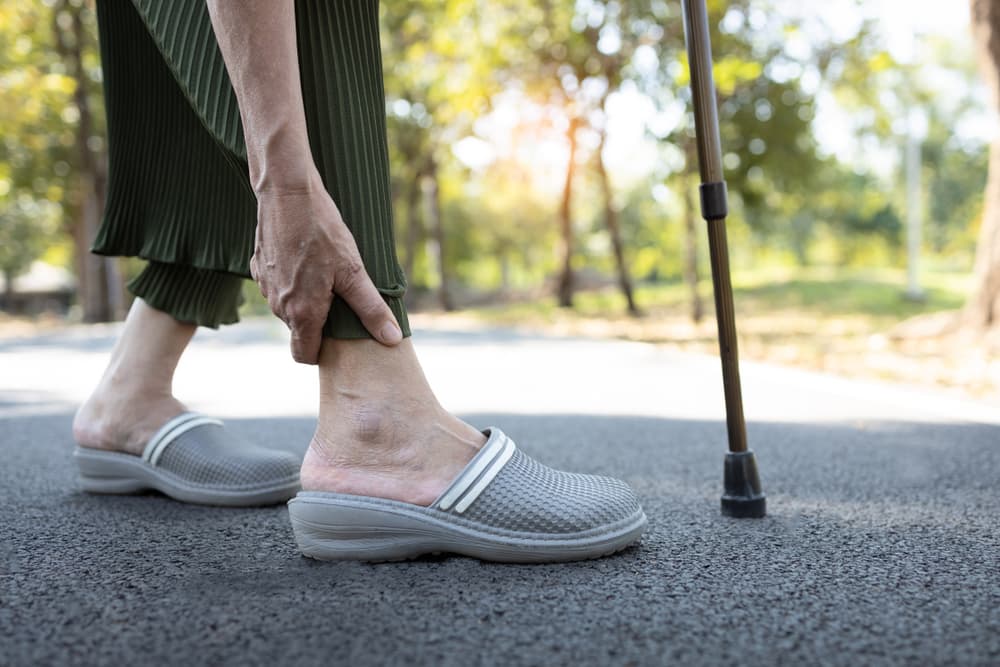
Causes of Poor Circulation in Feet?
Have you ever experienced numbness, weakness, or cramping in your feet or legs? These uncomfortable issues may be signs of poor circulation. Although you may be tempted to ignore it, poor circulation can lead to dangerous health conditions.
At USA Vein Clinics, we care about your circulation and overall vein health. If you notice symptoms of poor circulation in feet, legs, or other areas of your body, we are available to help. If vein disease is behind your reduced blood circulation, our vein specialists can recommend an effective treatment plan.
Below, we cover what you need to know about poor circulation in feet –– and what you can do about it.
 What Causes Poor Circulation in Feet?
What Causes Poor Circulation in Feet?
Poor circulation is a condition in which adequate blood flow does not reach certain areas of the body. This can occur for many different reasons, including a lack of physical activity or underlying health conditions.
Some potential causes include obesity, diabetes, high blood pressure, high cholesterol, Raynaud’s disease, and vein disease.
Lifestyle factors: An unhealthy lifestyle can impact your circulatory system. For instance, standing or sitting for prolonged periods can be major contributing factors to poor circulation in feet symptoms. Additionally, an elevated body mass index (BMI), smoking, eating a poor diet, and not drinking enough fluids can lead to circulatory issues throughout the body.
Certain health conditions: Some health issues, including obesity, diabetes, high blood pressure, and high cholesterol levels, can impact your the health of your heart and blood vessels. We recommend working closely with your doctor to manage underlying health conditions.
Raynaud’s disease: This ailment is another potential cause of poor circulation in hands, feet, and other areas of the body. It affects blood flow leading to the extremities, particularly the fingers. Women, as well as individuals living in cold climates, are more likely to develop Raynaud’s disease.
Vein disease: This common health issue, also known as venous insufficiency, can lead to poor circulation in feet, ankles, and legs. Vein disease occurs when tiny, one-way vein valves become damaged and struggle to carry blood against gravity to the heart.
If you have poor circulation, it is important to determine the underlying cause. Treatment may help alleviate poor circulation in feet symptoms.
Symptoms and Signs Of Poor Circulation In Feet and Legs
There are many potential signs of poor circulation in feet and legs. Some of these can involve pain or discomfort, which can be mild, moderate, or severe.
Poor circulation symptoms include:
- Numbness: You may notice reduced sensation or a tingling feeling in affected areas. It most often occurs in the extremities –– the legs, feet, toes, arms, hands, and fingers.
- Weakness: You may have trouble grasping objects or even carrying around your own body weight. You may also become easily fatigued.
- Muscle cramping: This can occur throughout the body and range from mild and uncomfortable to severe and painful. Most often, the calves are affected.
- Swelling: Unusual swelling can indicate vein disease or be a sign of deep vein thrombosis (DVT). DVT, when left untreated, can lead to a life-threatening issue known as pulmonary embolism.
- Cold extremities: When blood isn’t flowing through your body properly, your hands and feet may feel cooler than usual.
- Varicose veins: These bulging, twisted veins can occur when vein valves malfunction and blood begins to pool in affected areas. Varicose veins most often appear in the lower extremities.
- Venous ulcers: Venous ulcers are open, non-healing wounds and a sign of advanced vein disease. These require prompt medical attention since they can put you at risk for serious wound and skin infections.
- Weak pulse in the legs or feet: A weakened pulse in affected areas of the body can indicate poor blood flow.
- Pain: You may have pain or discomfort as a result of poor circulation. This can be sharp and shooting, or throbbing and aching, in nature.
- If you notice any of the above symptoms, we recommend seeking medical attention as soon as possible. Your doctor can make recommendations on how to improve poor circulation in feet, legs, and other areas of the body. If poor circulation in feet is the result of vein disease, a vein specialist can provide personalized treatment recommendations.
How to Improve Blood Circulation in Feet and Legs
 Poor circulation in feet and legs can be concerning, but there are multiple ways to improve the situation. Some of these include:
Poor circulation in feet and legs can be concerning, but there are multiple ways to improve the situation. Some of these include:
Lose excess weight: Being obese or overweight can put a strain on your veins and lead to sluggish blood flow.
Increase physical activity: Inactivity is a major contributor to poor circulation in feet and other areas of the body. Getting at least 30 minutes of exercise each day can get your blood flowing and improve your vein health.
Give yourself a foot massage: If you are stuck at your desk or standing at work all day, try massaging your legs and feet. This can help stimulate your blood flow.
Control underlying health conditions: If you have diabetes, high blood pressure, high cholesterol, or other health issues affecting circulation in the feet and other areas, it is important to manage these issues. Your doctor may recommend lifestyle changes, medication, or other interventions to help alleviate poor circulation in feet symptoms.
Wear appropriate footwear: Wearing tight or poor-fitting shoes can decrease your foot circulation. Be sure to choose comfortable footwear that allows your feet the space they need to move around.
Be attentive to wound care: If you have corns, calluses, or other types of wounds on your feet or legs, address them promptly. If left untreated in areas where circulation is poor, such wounds can worsen. In general, keep an eye out for any open, non-healing wounds and bring them to your doctor’s attention.
Eat a healthy diet: Focus on eating foods rich in Vitamins C, E, B, and Omega-3. These nutrients can increase oxygen levels, which in turn can increase blood flow.
Treat underlying vein disease: If venous insufficiency has impacted your circulation, we want you to know that there’s help available. Minimally invasive, office-based vein treatment can alleviate painful symptoms, reduce the risk of developing dangerous health issues, and improve your quality of life.
How To Prevent Poor Circulation
Many of the above recommendations on how to improve poor circulation in feet can also be used to prevent poor circulation. Getting enough exercise, losing excess weight, and generally following a healthy lifestyle are all positive steps toward maintaining healthy veins. It is also a good idea to quit smoking and limit alcohol and caffeine.
If you need help changing unhealthy lifestyle habits, talking to your doctor is a good start.
They can refer you to supportive resources, such as a medical weight loss center or smoking cessation program. We also recommend talking to your loved ones and close contacts about ways that they can support a healthier lifestyle.
If your job requires prolonged standing or sitting, try to take frequent breaks and move around as much as possible. Even while stuck in place, you can improve circulation by stretching your legs and feet or doing calf raises and ankle rolls. If you are at high risk for developing vein disease, ask your doctor about the benefits of wearing compression socks.
What Else Should I Know About Poor Circulation?
Poor circulation is not generally considered a disease in itself. As discussed above, it may be caused by or lead to other medical conditions. One related health issue is called peripheral artery disease (PAD). PAD is a progressive circulatory disorder that can result in pain and fatigue. If left untreated, PAD can increase your risk for heart attack, stroke, and limb amputation.
Deep vein thrombosis, or DVT, is another related health condition. DVT refers to the formation of a blood clot in a deep vein and usually causes pain and swelling. If you suspect you are experiencing a DVT, please seek immediate medical care.
How to Improve Poor Circulation in Feet at USA Vein Clinics
Our vein specialists at USA Vein Clinics can help resolve poor circulation due to underlying vein disease. We use a variety of techniques to treat varicose veins, spider veins, venous ulcers, and other venous conditions.
Most treatments take less than an hour, from start to finish. Treatment is performed in an office setting, so you can leave immediately afterward and return to most normal activities.
If you have poor circulation in feet symptoms and other signs of vein disease, please contact us at 888.768.3467. You can also schedule an appointment online. We offer a choice of in-office or telemedicine consultations. No matter where we meet, we look forward to helping resolve your painful, uncomfortable vein symptoms.

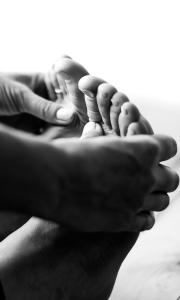 What Causes Poor Circulation in Feet?
What Causes Poor Circulation in Feet?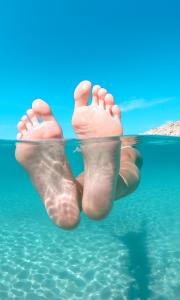 Poor circulation in feet and legs can be concerning, but there are multiple ways to improve the situation. Some of these include:
Poor circulation in feet and legs can be concerning, but there are multiple ways to improve the situation. Some of these include:


